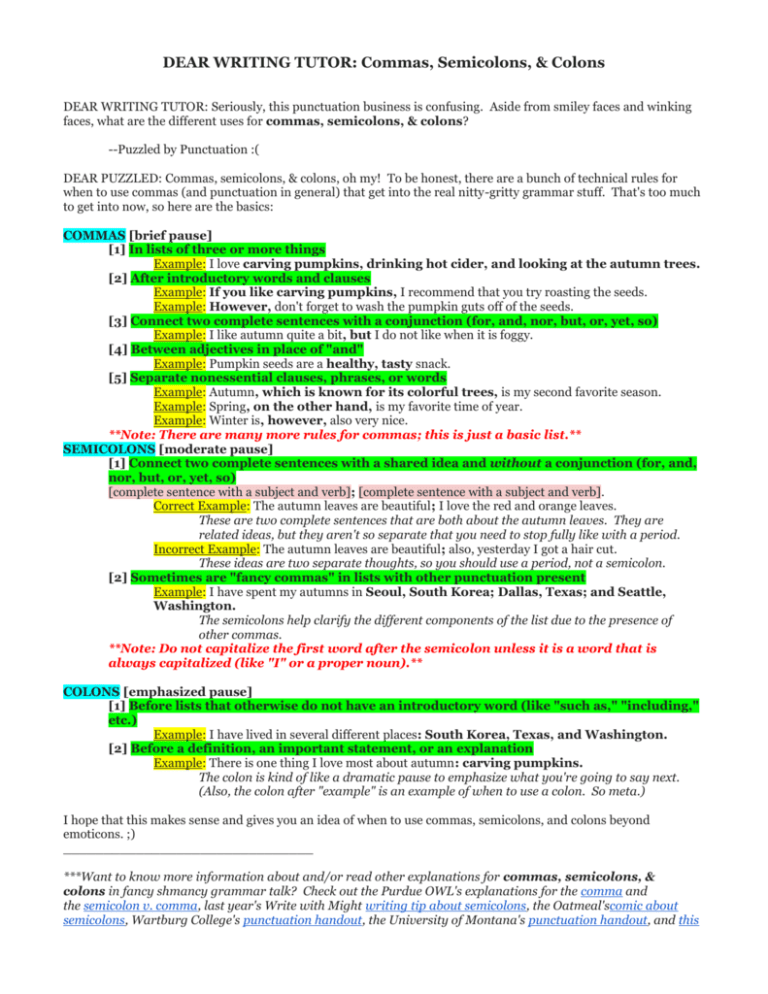Commas, Semicolons, & Colons
advertisement

DEAR WRITING TUTOR: Commas, Semicolons, & Colons DEAR WRITING TUTOR: Seriously, this punctuation business is confusing. Aside from smiley faces and winking faces, what are the different uses for commas, semicolons, & colons? --Puzzled by Punctuation :( DEAR PUZZLED: Commas, semicolons, & colons, oh my! To be honest, there are a bunch of technical rules for when to use commas (and punctuation in general) that get into the real nitty-gritty grammar stuff. That's too much to get into now, so here are the basics: COMMAS [brief pause] [1] In lists of three or more things Example: I love carving pumpkins, drinking hot cider, and looking at the autumn trees. [2] After introductory words and clauses Example: If you like carving pumpkins, I recommend that you try roasting the seeds. Example: However, don't forget to wash the pumpkin guts off of the seeds. [3] Connect two complete sentences with a conjunction (for, and, nor, but, or, yet, so) Example: I like autumn quite a bit, but I do not like when it is foggy. [4] Between adjectives in place of "and" Example: Pumpkin seeds are a healthy, tasty snack. [5] Separate nonessential clauses, phrases, or words Example: Autumn, which is known for its colorful trees, is my second favorite season. Example: Spring, on the other hand, is my favorite time of year. Example: Winter is, however, also very nice. **Note: There are many more rules for commas; this is just a basic list.** SEMICOLONS [moderate pause] [1] Connect two complete sentences with a shared idea and without a conjunction (for, and, nor, but, or, yet, so) [complete sentence with a subject and verb]; [complete sentence with a subject and verb]. Correct Example: The autumn leaves are beautiful; I love the red and orange leaves. These are two complete sentences that are both about the autumn leaves. They are related ideas, but they aren't so separate that you need to stop fully like with a period. Incorrect Example: The autumn leaves are beautiful; also, yesterday I got a hair cut. These ideas are two separate thoughts, so you should use a period, not a semicolon. [2] Sometimes are "fancy commas" in lists with other punctuation present Example: I have spent my autumns in Seoul, South Korea; Dallas, Texas; and Seattle, Washington. The semicolons help clarify the different components of the list due to the presence of other commas. **Note: Do not capitalize the first word after the semicolon unless it is a word that is always capitalized (like "I" or a proper noun).** COLONS [emphasized pause] [1] Before lists that otherwise do not have an introductory word (like "such as," "including," etc.) Example: I have lived in several different places: South Korea, Texas, and Washington. [2] Before a definition, an important statement, or an explanation Example: There is one thing I love most about autumn: carving pumpkins. The colon is kind of like a dramatic pause to emphasize what you're going to say next. (Also, the colon after "example" is an example of when to use a colon. So meta.) I hope that this makes sense and gives you an idea of when to use commas, semicolons, and colons beyond emoticons. ;) _______________________________ ***Want to know more information about and/or read other explanations for commas, semicolons, & colons in fancy shmancy grammar talk? Check out the Purdue OWL's explanations for the comma and the semicolon v. comma, last year's Write with Might writing tip about semicolons, the Oatmeal'scomic about semicolons, Wartburg College's punctuation handout, the University of Montana's punctuation handout, and this website about colons and semicolons. Julia Schneider, MSW Day/BASW Writing Tutor, is the author of Dear Writing Tutor. Have a writing-related question? E-mail Dear Writing Tutor at sswwrite@uw.edu or stop by the 238 Writing Alcove in the SSW.








